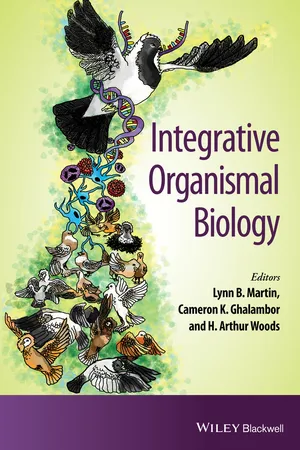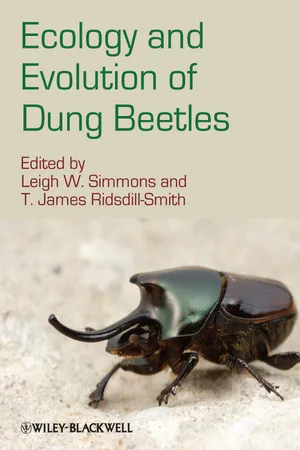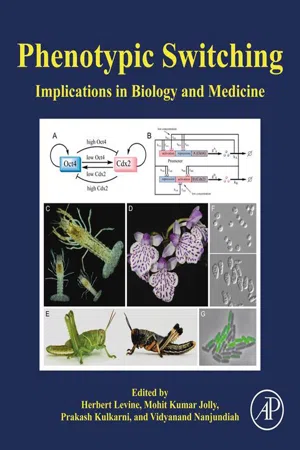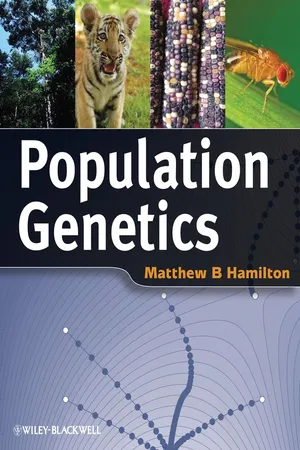Biological Sciences
Phenotypic Expression
Phenotypic expression refers to the observable characteristics or traits of an organism, resulting from the interaction between its genetic makeup and the environment. These traits can include physical features, behaviors, and physiological functions. Phenotypic expression is influenced by both genetic and environmental factors, and it plays a crucial role in understanding the relationship between genotype and phenotype in biological research.
Written by Perlego with AI-assistance
Related key terms
Related key terms
1 of 4
Related key terms
1 of 3
6 Key excerpts on "Phenotypic Expression"
- eBook - ePub
- Mukesh Verma, Debmalya Barh(Authors)
- 2016(Publication Date)
- Academic Press(Publisher)
Phenotype is basically the characteristics or traits of an organism which can be observed or detected through some means, for example, organism’s appearance, physiological or biochemical responses, development and psychological behavior. These characteristics of organisms are primarily caused by the genotype that is the information encoded in the collection of genes. The term “phenotype” seems to be straightforward in its meaning but its concept is often complex. One can think that any trait dependent upon the genotype is a phenotype, for example, human blood groups represent different phenotypes that are the accurate representation of genotypes. However, in some cases the phenotypes are also being regulated by the environmental factors that range from the habitat of the organism to the other influencing molecules. These variations in phenotypes due to environmental factors are also known as “ecophenotypic variation.” In another version, the influences of all these including genotype, environment, and genotype–environment interactions have been implicated on phenotype. In human beings, cephalic or cranial index (ratio of the maximum width of the head multiplied by 100 divided by its maximum length) of children is observed to be related to the area where a child is born, irrespective of the child’s genotype or cultural heritage. Thus phenomenon like epigenetics (alterations in phenotypes from changes in chromosome without any change in genotype), dual inheritance (influence of genetic and cultural evolution), polyphenism (different phenotypes arise from same genotype), and maternal effect (influence of environment and genotype of mother) can produce the complexity in understanding the possible phenotypes of patients.In literature, the concept of “phenotype” is presented differently. At least five definitions of phenotype can be found in the literature (Mahner and Kary, 1997 ). This may be due to the fact that phenotypes can now be measured quantitatively; observations can be made on different biological levels such as at systems, tissues, cellular, and molecular levels and due to the availability of sophisticated evaluation procedures. This led to the change of concept in the medical field from “the observable traits of an organism” to the “deviations from normal physiology, morphology, or behavior.” This determines that phenotype detection in the medical context is by taking physical and psychological evaluation, diagnostic tests, imaging, etc., to make the diagnosis for a medical problem. The more comprehensive concept of a phenotype can now be presented as the collection of noticeable properties of an organism, representing its physiology, its morphology at different levels, including cellular, tissue, organ, and body levels, and its behavior, incorporating even features such as the gene transcription in response to the environmental factors (Nachtomy et al., 2007 - eBook - ePub
- Lynn B. Martin, Cameron K. Ghalambor, H. Arthur Woods(Authors)
- 2014(Publication Date)
- Wiley-Blackwell(Publisher)
Chapter 6 Evolutionary Systems Biology: Shifting Focus to the Context-Dependency of Genetic EffectsMihaela Pavličev1 and Günter P. Wagner2,31 Cincinnati Children's Hospital, Cincinnati, OH, USA2 Department of Ecology and Evolutionary Biology, Yale University, New Haven, CT, USA3 Systems Biology Institute Yale University, West Haven, CT, USAThe phenotype is the name given to the results of the activities of genes. In a very simple organism, these activities may be carried out in a relatively short period, resulting in the formation, for instance, of a certain number of proteins. In more complex organisms, these proteins themselves interact with one another and with other substances so that it is a long and complex sequence of processes that the genes set in motion. (p. 9)C.H. Waddington, in Towards a Theoretical Biology v.I, 1968The phenotype is the product of the harmonious interaction of all genes. There is extensive interaction not only among alleles of a locus, but also among loci. The main locale of these epistatic interactions is the developmental pathway. (p. 184)E. Mayr, in Populations, Species and Evolution, 1970Introduction
Genes act through their many interactions during development and physiology to generate or maintain phenotypes. These interactions make gene effects mutually interdependent. In addition, genes are reused in many different contexts, generating shared genetic underpinning between the traits (pleiotropy). Thus neither genes nor traits can be seen as independent, but rather as components of more or less integrated wholes.This simple biological fact raises surprisingly difficult conceptual and methodological issues when describing the structure of genotype-phenotype relationships, assigning functional significance to genetic or molecular elements, and explaining evolutionary change. Indeed, many of the disagreements about the proper explanation of evolutionary change stem from this difficulty. At one extreme are gene-centered explanatory models that dominate population genetics-based theories of evolution. In these models, genes and allele substitutions are central mediators of causality. At the other extreme are a variety of developmental or systems-level explanatory models (Gould 2002). One example is the side-effect hypothesis of evolutionary novelties (Müller 1989), which claims that novel phenotypes appear as developmental side-effects of adaptive genetic changes elsewhere in the body. A related idea is the notion of developmental constraints as developed in the 1980s by Pere Alberch and others (Alberch 1983; Alberch & Gale 1983; Shubin & Alberch 1986; Alberch & Blanco 1996). In this and similar models of evolution, the loci of causal explanation are developmental interactions among embryonic traits. At both extremes, and in between, models have generated good empirical support, yet no synthetic view is available to resolve the apparent conflicts among models. - eBook - ePub
- David A. Baum, Douglas J. Futuyma, Hopi E. Hoekstra, Richard E. Lenski, Allen J. Moore, Catherine L. Peichel, Dolph Schluter, Michael C. Whitlock, David A. Baum, Douglas J. Futuyma, Hopi E. Hoekstra, Richard E. Lenski, Allen J. Moore, Catherine L. Peichel, Dolph Schluter, Michael C. Whitlock(Authors)
- 2013(Publication Date)
- Princeton University Press(Publisher)
phenotype encompasses morphological, behavioral, and physiological traits. For evolution of a phenotype to occur, it must have a genetic basis (i.e., be heritable). It is therefore necessary to understand the genetic underpinnings of phenotypic traits to understand the process of phenotypic evolution. This chapter will focus on the genetic and molecular basis of phenotypes that are adaptive; that is, phenotypes that contribute to fitness in a given environment. Although the genetics of adaptation has a long history of study, experimental progress was somewhat limited for much of the last century; however, recent technological advances in genetics and genomics have enabled the identification of genes and mutations that underlie phenotypic evolution in both plants and animals. These initial studies have begun to address long-standing questions about the number and effect sizes of the genetic changes that underlie adaptation, the types of genetic changes involved, the evolutionary history of the genetic changes, and whether the same genetic changes are used when similar phenotypes evolve in independent populations; however, more work needs to be done across a number of systems to gain a complete picture of the genetic basis for phenotypic evolution and adaptation. Fortunately, rapid progress in genome sequencing technologies and the development of new experimental systems are providing an unprecedented opportunity to understand the link between the environmental agents of selection and the phenotypic and genotypic targets of selection.GLOSSARYAdaptation. The process by which a population evolves to have higher fitness in a given environment.Enhancer. A DNA sequence that controls the expression of a gene; enhancers are also referred to as cis-regulatory elements.Inversion. A chromosomal rearrangement in which the sequence of DNA is reversed. When present in a heterozygous state, recombination is suppressed within the inversion.Phenotypic Effect Size - eBook - ePub
- Leigh W. Simmons, T. James Ridsdill-Smith, Leigh W. Simmons, T. James Ridsdill-Smith(Authors)
- 2011(Publication Date)
- Wiley-Blackwell(Publisher)
Chapter 6 Explaining Phenotypic Diversity: The Conditional Strategy and Threshold Trait ExpressionJoseph Tomkins1 and Wade Hazel21 Centre for Evolutionary Biology, School of Animal Biology, University of Western Australia, Crawley, Western Australia2 Department of Biology, DePauw University, Greencastle, IN, USA6.1 IntroductionVariation in Phenotypic Expression accounts for intraspecific diversity in an array of traits and behaviours across the animal kingdom, including caste, trophic, seasonal, dispersal and predator-induced polyphenisms, sex ratio investment (all reviewed in West-Eberhard, 2003; Roff, 1996), adaptations to sperm competition (Parker, 1990b) and the often spectacular alternative size-dependent reproductive phenotypes of males (Oliveira et al ., 2008). For nearly a century, the existence of such discrete phenotypic variation in natural populations has been of interest to ecological geneticists because it suggests a balance of selective forces at work (Sheppard, 1975). Specifically, it raises the intriguing question of why, over evolutionary time, one alternative phenotype does not drive the other extinct.Most of the classical ecological genetic studies of variation in nature – the coexistence of discrete differences in shell banding and colour in snails (Cain & Sheppard, 1954) and different mimetic forms characteristic of Batesian mimicry in butterflies (Clark & Sheppard, 1960) – have been aimed at understanding the kinds of selective forces that maintain discrete variation. Most of these studies concerned phenotypic differences that are due to the relatively straightforward expression of simple genetic differences.In the framework of evolutionary game theory, phenotypic differences that are linked to one or a few loci, and inherited in accordance with Mendelian ratios, have been termed alternative strategies (Gross, 1996; Maynard Smith, 1982). In such cases, negative frequency-dependent selection, where rare phenotypes have higher fitness than common ones, lies behind the maintenance of the phenotypic diversity seen within the population (Gross, 1996; Maynard Smith, 1982). For example, it has been shown recently that the survival of male colour morphs in wild populations of guppy (Poecilia reticulata ) is negatively frequency-dependent (Olendorf et al - eBook - ePub
Phenotypic Switching
Implications in Biology and Medicine
- Herbert Levine, Mohit Kumar Jolly, Prakash Kulkarni, Vidyanand Nanjundiah(Authors)
- 2020(Publication Date)
- Academic Press(Publisher)
11 Phenotypic switching and its evolutionary consequences Dragan Stajic and Claudia Bank, Gulbenkian Science Institute, Oeiras, Portugal Abstract In this book chapter, we discuss the importance of phenotypic switching with respect to adaptation. Hereby, we focus on epigenetic mechanisms of phenotypic switching that are involved in gene expression regulation. We start by placing the discovery of phenotypic switching in the context of the history of evolutionary biology. We highlight how the controversy about whether phenotypic switching can contribute to adaptation arose. We then present a nonexhaustive list of examples of epigenetic phenotypic switching in nature. Finally, we discuss several evolutionary hypotheses about the role of phenotypic switching in adaptation to new and fluctuating environments, and give examples of how these hypotheses have been addressed experimentally. Keywords Phenotypic switching; evolution; adaptation; epigenetic inheritance; gene expression; mutation Biological systems are characterized by stunning diversity. This diversity is reflected in variation of observable characters (i.e., phenotypes) both between individuals within the same and between different species (Darwin, 1895). Studying how this variation among individuals in the same population is generated and maintained, and how it translates into the differences that we can observe within and between species is the essence of evolutionary biology. The main source of observable phenotypic diversity is genetic changes that are stably transmitted to subsequent generations (Fig. 11.1). Natural selection acts on these inherited phenotypes by preserving the beneficial and erasing the deleterious ones, causing a corresponding change in frequency of the underlying genetic determinants in the population. However, phenotypes can also be determined and maintained by molecular mechanisms that are independent from the underlying functional DNA sequence - eBook - ePub
- Matthew B. Hamilton(Author)
- 2011(Publication Date)
- Wiley-Blackwell(Publisher)
Another primary cause of variation among individuals in quantitative traits is the environment. Even if there is only a single genotype, the phenotype expressed by each individual in a population will vary somewhat depending on the environmental conditions each individual experiences. For example, the biomass and fruit production of plants is impacted by the amount of sunlight and nitrogen each individual receives. Another example of environmental variation in quantitative traits is the roleFigure 9.3The effect of environmental variation on phenotypic variation. The phenotypic distribution on the left is produced by two Mendelian loci with all allele frequencies equal to ½s in Figure 9.2 . If the environment causes some variation in the phenotype expressed by each genotype, then the distribution of phenotypes produced by polygenic variation becomes both smoother and wider. In this illustration, environmental variation causes 50% of the individuals of each genotype to randomly increase or decrease one unit in phenotypic value. Although the average effect of environmental variation here is a zero change in phenotypic value, the phenotypic variance increases.of diet and exercise in human disease, where better conditions tend to lessen the frequency or severity of disease phenotypes. Figure 9.3 shows how environmental differences among individuals contribute to the continuous distribution of phenotypic variation. The left-hand panel of Fig. 9.3 shows the five phenotypes produced by a trait due to two diallelic loci. If each phenotypic class expressed by a genotype is modified by environmental variation, the distribution of phenotypes becomes both wider and smoother as shown in the right-hand panel of Fig. 9.3
Index pages curate the most relevant extracts from our library of academic textbooks. They’ve been created using an in-house natural language model (NLM), each adding context and meaning to key research topics.
Explore more topic indexes
Explore more topic indexes
1 of 6
Explore more topic indexes
1 of 4





